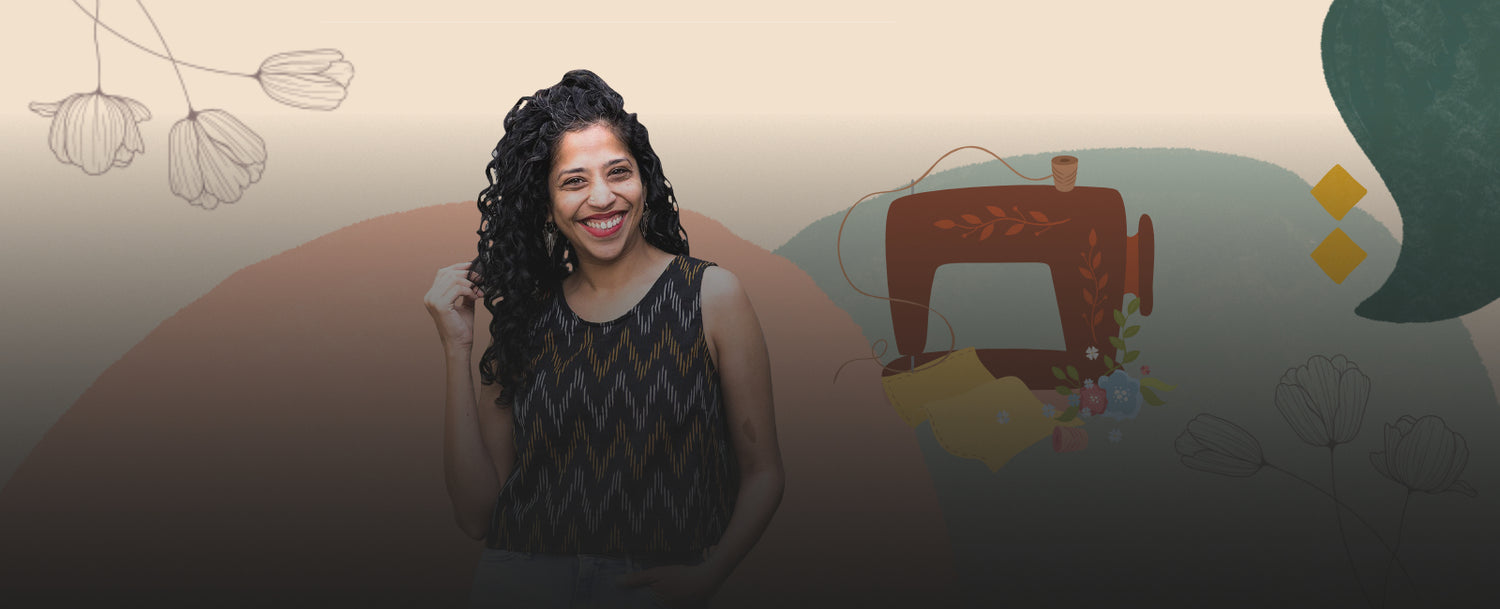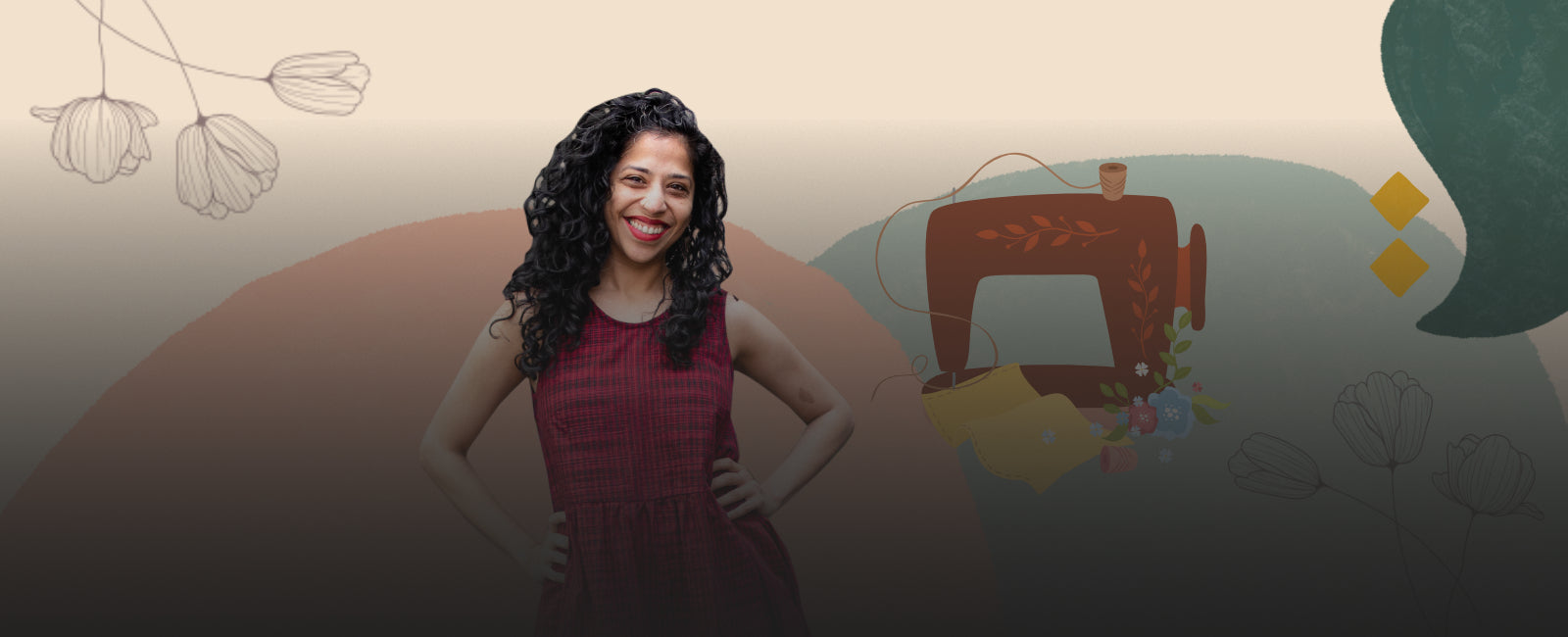Hey all,
Welcome to this collaborative blog series where I walk you through how I used the lovely fabrics available at Fabriclore to sew up some garments.
Through this blog series I will help you understand what sewing patterns are and how to use these patterns to sew your own garments at home. I will introduce you to some great designers and places where you can download free patterns to test your new skills. We will start with simple beginner friendly patterns, learn to hack these patterns and move up in complexity as we progress through the series. This blog is also meant to give you inspirations on the different types of garments the Fabriclore collections can be used for. By the end of this, you may never need your tailor again .
So come join us in this exciting sewing journey!
For the first post, I have chosen to make a simple sleeveless crop top called the Ashton Top by Helen’s Closet Patterns.


Now let’s move on to sewing up the Ashton Top
The Pattern
The Ashton top pattern has two views. A hip length (view A) and a cropped version (view B). Both views have bust darts and an A-line shape which gives it a very relaxed yet flattering look. The pattern also gives you 2 different options of finishing the neckline and armholes depending on how you like your garments finished!
This pattern would look great with both pants and skirts. Check out all the versions of it on Instagram using the hashtag #ashtontop . There is an option to add sleeves to this pattern if you choose to buy the sleeve expansion pack (also on sale until May 31st 2021 with the same discount code fabriclore2021ashton).
(Helen has a great eye for simple wearable designs that fit well in your everyday wardrobe. She also grades her designs to fit a large size range making her sewing patterns very inclusive. Importantly, she is excellent at writing out very detailed instructions which is perfect for beginners. Check out all her patterns on Helen’s Closet )
Helen has generously given all Fabriclore customers a 20% discount code on the Ashton top pattern. USE CODE: fabriclore2021ashton during checkout at the Helen’s Closet website. This code will be valid for both the Ashton top and the sleeve expansion pack. The code is valid until May 31st, 2021.
With such a classic design, this pattern can be easily hacked into many different garments. For my second post, I have hacked the Ashtop top into a dress! Look out for the next post!
One of most versatile and fun part of garment sewing is being able to understand what looks good on your body and make the changes to the garment accordingly. I am short waisted. This means that the distance between my waist and my hips is shorter than average. Therefore, for most garments, I have to shorten the bodice for it to fit well. For short-waisted people like myself, garments that hit just above your high hips is very flattering. I therefore prefer to wear more cropped tops. For this post, I chose to make View B, the cropped version. I also chose to finish the neckline and armhole using the bias binding method.
The Fabric
For a beginner sewist, cotton textiles are the easiest to work with for garment making. Not only is it the best kind of fabric for the summer, but it is also one of the most sustainably made fabrics worldwide. The Fabriclore collection has so many beautiful cotton fabrics to choose from. For this pattern, I chose to use a lovely washed Ikat fabric with a chevron design.
The fabric is lightweight with great color saturation. It has a light hand and drape and would work well for so many different kinds of woven garments. I highly recommend trying out this fabric. Importantly, cotton fabrics are wonderful to handle while sewing. Pressing and steaming cotton while sewing is a total dream!
That’s said, the Ashton top would look wonderful in any woven fabric. A lovely rayon or Tencel will make this top stand out and give it a different silhouette.
Tools needed
The tools needed to sew this garment is pretty similar to any sewing project. Here is a list along with what it is used for.
For Sewing -
- A sewing machine: No fancy sewing machine I needed to sew garments. As long as the machine can sew a straight stitch and a zig zag stitch you are good to go.
- A serger (optional): A serger, or an overlocker, is a machine that will finish the seams while cutting the fabric edge evenly at the same time. If you don’t have a serger, you can use an overcast stitch or a zig zag stitch on your regular sewing machine.
- Needles: For your sewing machine and extra needles of different sizes (different fabrics will need different types of needles).
- Thread: I like to use all sew gutterman thread for most garments. These are strong polyester thread.
- Pins: to hold your fabric in place while sewing
For Cutting -
-
Fabric shears (I use my fabric shears to only cut fabric)
-
Rotary cutter (optional): Personally, I prefer to use a rotary cutter and cutting mat to cut out my pattern pieces. I find it is more precise and a faster process. A lot of other sewist prefer using shears so give it a try if you can.
-
If you are using a rotary cutter, you will need a self-healing mat to cut on. They come in a variety of sizes for your convenience. Mine is a 24inX36in.
-
Clear rulers with both inches and cms marked on it.
-
Thread snips for cutting small thread hanging
-
Steam iron and ironing board/surface
-
Tailor’s ham (optional): This tool sis wonderful for ironing part of the garment that are not flat like darts. You can use a rolled towel if you don’t have a tailor’s ham.
-
Tailors’ clapper (optional): This tool is great for keep seams flat. It is not an essential tool, but it does add a much better finish to your garment.
Apart from this if you choose to print out your pattern, you will need a printer. That’s it for now. Once you are comfortable sewing garment, you can slowly add to your collection.
Choosing a size
The sizing in the sewing community is very different from what you find at a store with ready to wear garments. Each pattern designer has his/her own size chart that she uses to grade the pattern. Each pattern also has a certain amount of ease added to the garment which is what allows us to move with easily in the garment. We can talk more about ease in a few minutes.
The best way to show you is by example so I will walk you through how I make size decisions for different patterns according to your size.
To choose a size, you have to first take accurate measurements of yourself. This can sometimes be hard. I recommend watching this YouTube video made by Made to Sew on how to measure yourself. This YouTube channel also has amazing video tutorials for many sewing techniques. Watch at your leisure.
The most important measurements you will need for most garments are your high bust, bust, waist and hips

Here are my measurements -
Upper bust – 34”
Bust – 36”
Waist – 28”
Hips 37”
Now let’s look at the Helen’s closet size chart.

My measurements put me at approximately a size 10 on the bust and a size 8 on the waist and hips.
No one can be all the same size. People come in all different sizes and so we will therefor fit into a multiple size range. Once I have seen which size range/s that I fall into I also look at another chart that is usually provided in most patterns – The finished garment measurement.
This set of measurements is very useful to have because your finished garment measurements will depend on how much ease the designer decided to give to the pattern. Personally, I like to wear tops that a more fitted at my bust and looser at my hips, so I can choose my size by seeing both sets of measurements.

This new size chart tells me that if I choose to cut out a size 10, I have about 4 inches of ease in the high bust (38.5-34.5) and my bust. This is a lot of ease in my opinion. I prefer to wear something that has about 2 inch of ease. This gives me enough room for movement and is more flattering. So, looking at the finished garment measurements I find that size 6 gives me 2 inch if ease in my high bust and bust. The waist and hip measurements are much larger than my own so size 6 would probably give me a much better overall fit.
Making a Toile
As a beginner sewist, it may be hard to make such decisions. What I would highly recommend for all beginner sewists is to start at one size. Maybe a size 10 which is the recommended size for my measurements and make a fit test garment or a toile. A toile is usually made in a similar type of garment as your final garment, but this is not always possible. So, find old cotton bedspreads and start cutting them up
Once you make a toile, you can decide if you are comfortable with that ease, if you like the fit and then see if you need to size up or down or make other adjustments.
There are several other fit adjustments that maybe needed for each of you to get the right fit. You may need to change the position of the dart, shorten/lengthen the garment or do a full or a small bust adjustment. Helen gives you fitting instructions for different adjustments. I urge you to assess your toile and test these changes. This is one of many reasons why the home sewing world has exploded. The pattern designers are not only selling amazing patterns, but they are also providing for free many fitting tutorials to help you make the right adjustments for you. I highly recommend investing in some patterns to help you in this process.

Pattern pieces and Cutting the fabric
Another aspect to look for in patterns is if they have these sizes layered. This allows you to choose just the sizes that you are interested in and only print those out. The layers in the PDF is revealed when you open it in Adobe Acrobat!
As I mentioned earlier, you have different options of printing out this pattern. You can choose the print at home method where are can print the pattern pieces on A4/Letter sized papers and stick them together and cut out your patterns or you can get it printed in a copy shop sized paper and then cut or trace out your pattern pieces. I believe now you also may have projector files which completely removes printing the patterns and allows you to project the pattern outline directly onto your fabric to cut.
My preferred method is to print at home only the sizes I want and stick my pattern pieces together with clear scotch tape. I then use my paper cutting scissors to cut up the pattern pieces.
Most pattern designers will also provide you with fabric requirements for each size. This helps with buying the right amount of fabric for the project. When you receive your lovely new fabric from Fabriclore, please check the washing instructions and wash your fabric and dry your fabric. I also like to use a nice heavy steam iron and press my fabric before cutting. This helps remove all wrinkles in the fabric which give you more precise cutting of the pattern pieces
Once you have chosen you size and printed and cut out your pattern pieces, it is time to cut the fabric. Before you cut the fabric you can make all the changes you choose to the pattern pieces. I decided to make a straight size 6 with no modifications.
The pattern instructions also give you a suggested cutting layout. These layouts are useful because it is almost always designed so that you economically use the amount of fabric you have on hand creating less waste. Since usually fabric comes in different widths, the fabric amounts and cutting layouts will also be provided for both those widths for your convenience.
I usually pin my pattern to the fabric and cut with rotary cutters. There are several videos you can watch that help you understand how to cut your fabric. All pattern pieces will have an arrow or a line on the piece. This is called the grainline and we want this line to be parallel to the selvedge edges of the fabric most of the time. Use this blogpost to learn how to lay your pattern pieces and cut your fabric .

Some of my pattern pieces laid out and pinned to the fabric, ready to be with my rotary blade
Once you cut all the pattern pieces, you will have mark all the notches and other markings on the patterns. Please watch this video that explains how to read a sewing pattern . In the instructions to Ashton top, Helen also gives you all details of what marking to transfer onto the fabric.
For the Ashton the important marking are the bust darts. I am not using a facing to finish the neckline and armholes so those notches are not relavant.
To make my bust dart:
- I first make small snips at the edges of the dart. These snips are about 1/8th of an inch in length. Large snips may not stay in the seam allowance and cut into the garment itself.
- I use a pin to mark the bust apex.

Marking the bust dart
-
I use my chalk to draw a line from the snipes notches to the bust apex. This is done on the wrong side of the fabric.

Bust dart marked
-
I mark other relevant notches with small snips.

Marked all other notches
After this step follow all instructions in the pattern very closely. I am adding some of the photos of a few of the steps during the process.
-
Sew the bust darts and press it using a tailors ham.

Sewing the dart
-
French seam the front and back bodice at the shoulder and the side seams. Helen give you exact instructions on how to French seam. I love this finishing and try to use it on my clothes as often as possible.

French seaming the shoulder seams
-
Add the bias binding to the neckline and the armholes as instructed

Using the bias binding to finish the armhole
Helen gives you great instructions on how to attach the bias binding to finish off the neckline. But if you prefer to learn with videos, watch Dana from Made Everyday’s tutorial. Helen has an extra understitching step to her method which can be optional.
-
Finally, we finish off the garment with a beautiful hem band. Having a hem band will allow you to play a bit with your fabric and add contrasting hem and bias binding!
-
Give your top and nice press and enjoy wearing it!
Techniques you will learn
If you choose to make this top you will
- Learn to sew French seams
- Learn to sew bust darts
- Learn to finish a neckline with bias binding or an enclosed facing
- Learn to attach a hem-band

Beyond the pattern
One of the most exciting parts of learning to sew a garment is, once you have made fit adjustments you can then hack the pattern to make a different garment out of it. One of the easiest hacks is to attach a skirt to this top to make it into a dress. I performed this exact hack to make a beautiful, tiered dress.
Here's the detailed blog to make your own dress with same pattern!
If you do try the pattern or simply sew your own patterns, share in the comments below. Let's inspire each other.
Author: Swetha Mohan




